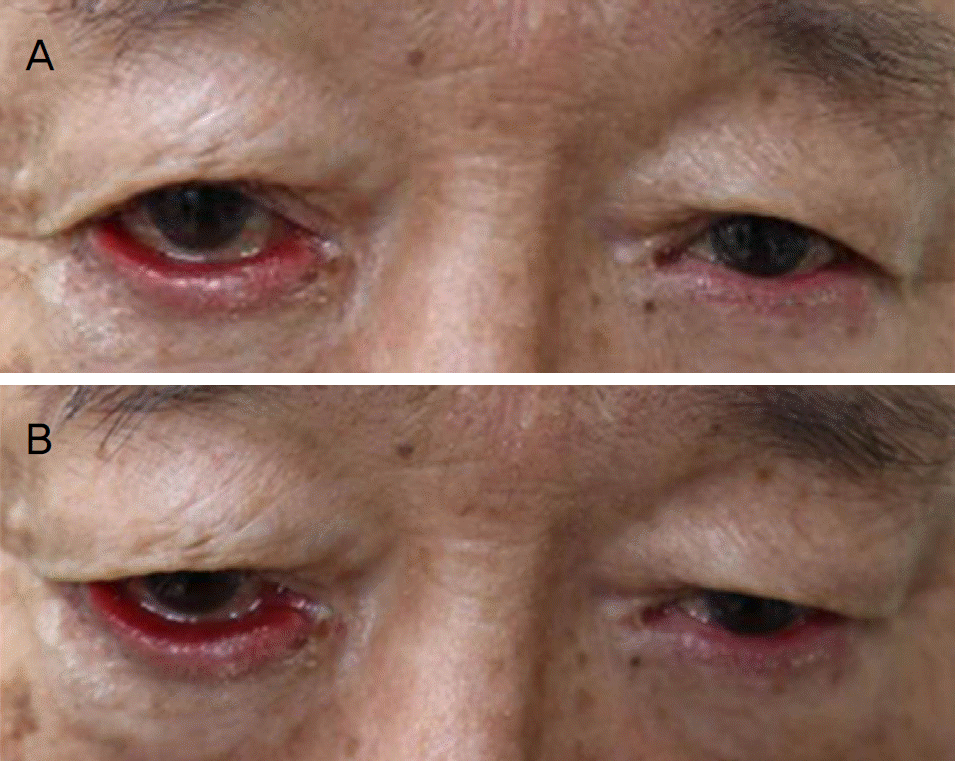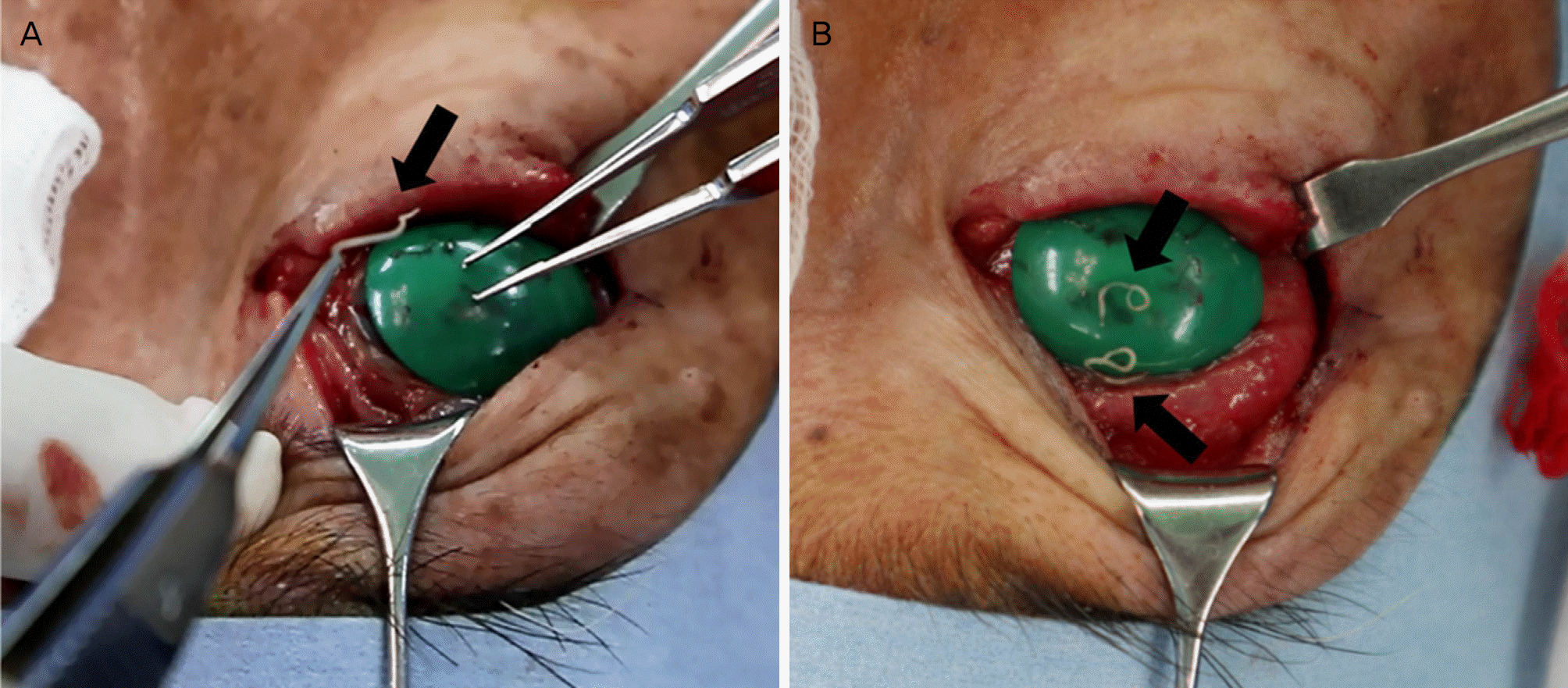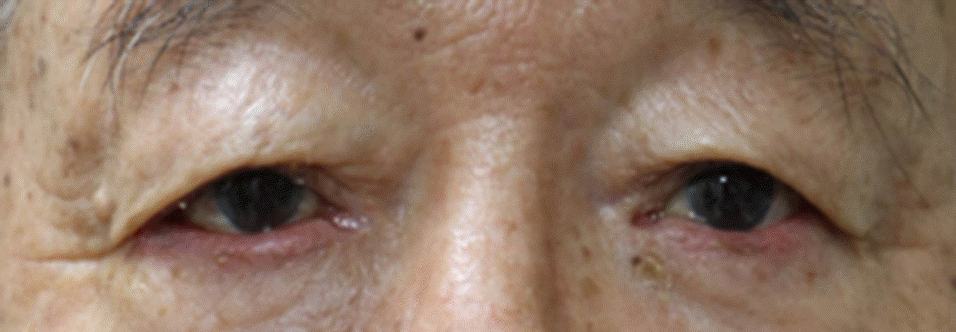Abstract
Case summary
A 79-year-old man presented with epiphora and a sensation of a foreign body in his right eye that had persisted for several months. On the initial examination, he had conjunctival injection, conjunctival follicles, telangiectasia of the lid margins, meibomian gland dysfunction, and tarsal ectropion. We performed a lateral tarsal strip operation to treat the tarsal ectropion. During surgery, we identified and removed four parasites (about 1–2 cm in length and 0.5 mm in width) that had not been apparent on slit lamp examination. The parasites were identified as Thelazia callipaeda. The patient's symptoms sub-sequently improved considerably; he has followed up to the present time without recurrence.
Conclusions
In the presence of continuous extraocular inflammation, as with infestation by Thelazia callipaeda, ectropion can be induced by several possible causes. Involutional ectropion can be accelerated mechanically through rubbing. Other causes include inferior force from inflammation of the connective tissue and temporary blepharospasm.
Go to : 
References
1. Burnett HS, Parmelee WE, Lee RD, Wagner ED. Observation on the life cycle of Thelazia californiensis. J Parasitol. 1957; 43:433–8.
2. Choi WY, Youn JH, Nam HW, et al. Scanning electron microscopic observations of Thelazia callipaeda from human. Korean J Parasitol. 1989; 27:217–23.

3. Seo M, YU JR, Park HY, et al. Enzooticity of the dogs, the reservoir host of Thelazia callipaeda, in Korea. Korean J Parasitol. 2002; 40:101–3.

4. Nakata R. Study on Thelazia callipaeda. Jpn J Parasitol. 1964; 13:600–9.
5. Otranto D, Lia RP, Buono V, et al. Biology of Thelazia callipaeda (Spirurida, Thelaziidae) eyeworms in naturally infected definitive hosts. Parasitology. 2004; 129(Pt 5):627–33.

6. Otranto D, Traversa D. Thelazia eyeworm: an original endo- and ecto-parasitic nematode. Trends Parasitol. 2005; 21:1–4.
7. Trimble CG. Circumocular filariasis. China Med J. 1917; 31:266.
9. Nakata R. Example of the parasite Thelazia callipaeda in human in Korea. J Chosen Med Assoc. 1934; 24:939–44.
10. Zakir R, Zhong-Xia Z, Chioddini P, Canning CR. Intraocular infestation with the worm, Thelazia callipaeda. Br J Ophthalmol. 1999; 83:1194–5.

12. Lee SW, Kang SW, Lee JO, Eom KS. Two cases of thelazia callipaeda infestation. J Korean Ophthalmol Soc. 1994; 35:1132–6.
13. Kim HT, Lim SJ, Kim JW. A case of Oguchi's disease. J Korean Ophthalmol Soc. 1990; 31:105–9.
14. Choi DK, Cho SY. A case of human Thelaziasis concomitantly found with a reservoir host. J Korean Ophthalmol Soc. 1978; 19:125–9.
15. Maden A, Söylev MF, Ozkan SB. Acute onset transient ectropion associated with corneal ulcer. Int Ophthalmol. 1998; 21:323–4.
Go to : 
 | Figure 1.Preoperative patient's clinical photographs. On the first visit, a 79-year-old man presented with ectropion, blepharitis on the right lower eyelid. (A) Straight ahead gaze. (B) Downgaze. |




 PDF
PDF ePub
ePub Citation
Citation Print
Print




 XML Download
XML Download